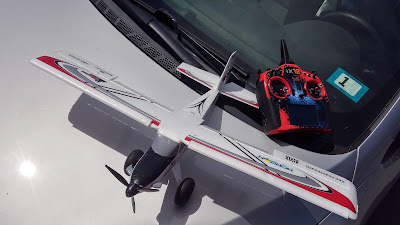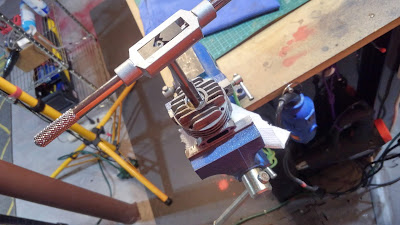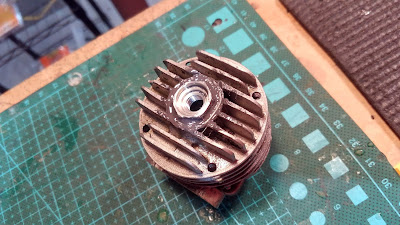All good! Tomorrow I will see if the returned 10cc engine will run in the Spitty. Once that's assured, I want to fly a few more times on the iX12, though I confident with it, before maidening the Spitfire. Given my past history with Spitfires I want no doubts.
The flying monkeys got me...
Monday, August 31, 2020
Daddy's got his Mojo back!
Sunday, August 30, 2020
Brain said "ABORT!", thumbs said, "WE GOT THIS!"
And that folks, is why we should not fly with our thumbs, but rather with our brains. This happened a couple of days ago, and I didn't want to revisit it...
Big 18x10 prop on an 26cc, its got some kinda torque roll. She had a bit of torque roll with the 17x8 I had on her, so no surprise this would be worse. Started the take off roll and she needed left rudder, then a little left aileron, then she needed more, than started to fly and rolled left, backed off power, Brain said, "ABORT!", but the Thumbs said, "WE GOT THIS! POWER!", she lifted more and rolled more, off the runway at 1 foot AGL and her right wing struck the high weeds, she tumbled in on to her nose. I was stunned and mad at myself! So pissed I forgot to take a photo of the crime scene, so the first pic is after pulling her out of the weeds and setting her on the runway.
Tuesday, August 25, 2020
Waco Adjustments
Last flights with the Phoenix Waco RCGF-USA 26cc, I noticed the need for a LOT of right up aileron to correct a left roll. Back in the workshop it was apparent that the left wing, which is the one I remove for transport, had a small neg deflection in the leading edge of the upper wing. I corrected this with a shim and a re-drill of the alignment peg hole inboard and installed a small shim on the outboard side. This gave her a good incidence which I think will alleviate the problem. We'll see next time I take her out.
Soft RCGF (Original) Threads...
One of the few problems with the original version RCGF 10cc engine is the soft threading of the spark plug site at the top of the cylinder (this engine is now "obsolete", and this is not a problem with RCGF-USA 10cc Stinger engines). As of today I have stripped 3 of these in 9 years. Today was removing a spark plug wire from one of the oldest engines I have, probably 9 yrs old now, and the whole sparky came out still attached to the ignition plug adapter, stripped clean from the cylinder!
Monday, August 24, 2020
The Perfect Swing!
Sunday, August 23, 2020
Thunderstorm on Mt Hudson August 23, 2020
It started out as a beautiful day, no winds but for some brisk occasional gusts. These became more frequent, but the skies were scantily clouded. An hour later that changed rapidly. The storm came from the west, and you could see the first thunderhead forming right overhead. It got dark, then a light rain. I closed up my car, but thought that I could still fly, but by the time I got back to the electric side of our field (the west) I could hear the rain hitting the trees on the west side of the runway and called out to the boys, "HERE IT COMES!". I though maybe just some rain. It rapidly became a storm with wind, hail, thunder and dense hard rain. Being on the downhill side I was soon ankle deep in runoff. A gust shot across the field to the shelter I was under and twisted the Cubby in my hand, cracking the horizontal stabilizer, easily fixed when I got home. Wx radar indicated this wasn't going away for a few hours, so I left, telling the boys what the radar indicated. Slow moving storm. When I left it was still pouring, and at the outer gate to the dump the rain water was over my ankles not 20 min after it started. As I filmed this I was so hoping it wasn't going to turn into a news video of how a bunch of guys got hit by lightning in Hudson!
Saturday, August 22, 2020
All set to fly tomorrow!
Programming the AS3X using Forward Programming
Friday, August 21, 2020
Waco RCGF-USA 26cc All Set!
The Phoenix Waco is one of my absolutely favorite planes to fly. For that reason I didn't rush to program her into the Spektrum iX12, which is a good thing considering how it misbehaved recently. It hangs in a special prominent ceiling corner of my basement shop where I can gaze upon it in love and admiration. Since the iX12 is in the shop, and I haven't removed any of the aircraft from my DX8, I decided to go ahead and set up the Waco for the season. Its very late this year... but conditions have not been favorable for flying this summer with remarkably windy days, even for a big girl like the Waco. Today is clam but with frequent gusts to 20-25 mph... typical this year.
Objective Comparison of Orange, Lemon and Spektrum Receivers
Note that the range on the Y axis vary so visual height of the peaks is not comparable. I don't know what the height or length of the peaks mean (in the Spektrum graph the fade lines don't always zero). Visually you can see a marked difference in density of fades.
My take away is this:




















































